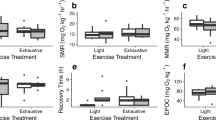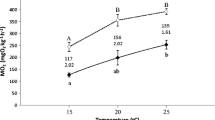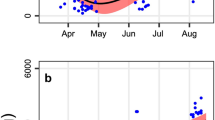Summary
Capture by angling was used to induce burst exercise in northern pike. By 3 h after exercise blood lactate had risen to levels of 15.2 mmol l−1 (Fig. 2), which greatly exceeded the maximum post-exercise levels (4.0 mmol l−1) previously reported for muskellunge, a close relative of pike. White muscle lactate level was high, 41.8 mmol kg−1, immediately after capture but declined to 23.2 mmol kg−1 by 6 h (Fig. 2). Blood glucose level more than doubled after exercise and remained elevated even after 96 h of recovery (Fig. 2).
During the first 6 h after angling, pike disposed of 9.57 mmol (861 mg) of lactate per kg body weight. A whole body metabolic rate of 153 mg O2 kg−1 h−1 is sufficient to account for this rate of lactate removal through oxidation (Table 3). However, the metabolic rate of the highly oxidative organs and tissues (red muscle, gills, liver, kidney, heart, and spleen) must be very high (>1,000 mg O2 kg−1 h−1) to oxidize even 60% of the lactate that disappeared from pike after exercise (Fig. 5).
Mortality of pike from angling stress was less than 3%.
Similar content being viewed by others
Abbreviations
- MW :
-
molecular weight
- KOH :
-
potassium hydroxide
- CI's :
-
confidence intervals
- MR :
-
metabolic rate
References
Barker SB, Summerson WH (1941) The colorimetric determination of lactic acid in biological material. J Biol Chem 138:535–554
Batty RS, Wardle CS (1979) Restoration of glycogen from lactic acid in the anaerobic swimming muscle of plaice,Pleuronectes platessa L. J Fish Biol 15:509–520
Beggs GL, Holeton GF, Crossman EJ (1980) Some physiological consequences of angling stress in muskellunge,Esox masquinongy Mitchill. J Fish Biol 16:115–122
Bendall JR, Taylor AA (1970) The meyerhof quotient and the synthesis of glycogen from lactate in frog and rabbit muscle: A reinvestigation. Biochem J 118:887–893
Bilinski E, Jonas REE (1972) Oxidation of lactate to carbon dioxide by rainbow trout (Salmo gairdneri) tissues. J Fish Res Bd Can 29:1467–1471
Black EC (1958) Hyperactivity as a lethal factor in fish. J Fish Bd Can 15:573–586
Black EC, Connor AR, Lam K-C, Chiu W-G (1962) Changes in glycogen, pyruvate and lactate in rainbow trout (Salmo gairdneri) during and following muscular activity. J Fish Res Bd Can 19:409–436
Black EC, Manning GT, Hayashi K (1966) Changes in levels of haemoglobin, oxygen, carbon dioxide, pyruvate and lactate in venous blood of rainbow trout (Salmo gairdneri) during and following severe muscular activity. J Fish Res Bd Can 23:783–795
Black EC, Robertson AC, Hanslip AR, Chiu W-G (1960) Alterations in glycogen, glucose and lactate in rainbow and Kamloops trout,Salmo gairdneri, following muscular activity. J Fish Res Bd Can 17:487–500
Bouck GR, Ball RC (1966) Influence of capture methods on blood characteristics and mortality in the rainbow trout (Salmo gairdneri). Trans Am Fish Soc 95:170–176
Brett JR (1964) The respiratory metabolism and swimming performance of young sockeye salmon. J Fish Res Bd Can 21:1183–1226
Brett JR (1972) The metabolic demand for oxygen in fish, particularly salmonids and a comparison with other vertebrates. Respir Physiol 14:151–170
Driedzic WR, Hochachka PW (1978) Metabolism in fish during exercise. In: Hoar WS, Randall DJ (eds) Fish physiology, vol VII. Academic Press, New York, San Francisco, London, pp 503–543
Gordon MS (1972a) Comparative studies on the metabolism of shallow-water and deep-sea marine fishes. I. White-muscle metabolism in shallow-water fishes. Marine Biol 13:222–237
Gordon MS (1972b) Comparative studies on the metabolism of shallow-water and deep-sea marine fishes. II. Red-muscle metabolism in shallow-water fishes. Marine Biol 15:246–250
Hermansen L, Vaage C (1977) Lactate disappearance and glycogen synthesis in human muscle after maximal exercise. Am J Physiol 233:E422-E429
Hochachka PW (1961) The effect of physical training on oxygen debt and glycogen reserves in trout. Can J Zool 39:767–776
Hochachka PW (1980) Integrative mechanisms in hypoxia-adapted fish. In: Living without oxygen: Closed and open systems in hypoxia tolerance. Harvard University Press, Cambridge, Massachusetts, London (Chapter 7, pp 100–116)
Holmes WN, Donaldson EM (1969) The body compartments and the distribution of electrolytes. In: Hoar WS, Randall DJ (eds) Fish physiology, vol I. Academic Press, New York San Francisco London, pp 1–89
Johnston IA (1982) Physiology of muscle in hatchery raised fish. Comp Biochem Physiol: special issue on fish biochemistry 73B:105–124
Johnston IA, Ward PS, Goldspink G (1975) Studies on the swimming musculature of the rainbow trout. I. Fibre types. J Fish Biol 7:451–458
Kobayashi KA, Wood CM (1980) The response of the kidney of the freshwater rainbow trout to true metabolic acidosis. J Exp Biol 84:227–244
Lanctin HP, McMorran LE, Driedzic WR (1980) Rates of glucose and lactate oxidation by the perfused isolated trout (Salvelinus fontinalis) heart. Can J Zool 58:1708–1711
Love RM (1970) The chemical biology of fishes. London, Academic Press
Mazeaud MM, Mazeaud F, Donaldson EM (1977) Primary and secondary effects of stress in fish: some new data with a general review. Trans Am Fish Soc 106:201–212
Miller RB, Miller F (1962) Diet, glycogen reserves and resistance to fatigue in hatchery rainbow trout. Part II. J Fish Res Bd Can 19:365–375
Miller RB, Sinclair AC, Hochachka PW (1959) Diet, glycogen reserves and resistance to fatigue in hatchling rainbow trout. J Fish Res Bd Can 16:321–328
Newsholme EA, Start C (1973) Regulation in metabolism. Wiley, London
Parker RR, Black EC (1959) Muscular fatigue and mortality in troll-caught chinook salmon (Oncorhynchus ishawytscha). J Fish Res Bd Can 16:95–106
Perrier C, Terrier M, Perrier H (1978) A time-course study of the effects of angling stress on cyclic AMP, lactate and glucose plasma levels in the rainbow trout (Salmo gairdneri Richardson) during a 64 h recovery period. Comp Biochem Physiol 60A:217–219
Raabo E, Terkildsen TC (1960) On the enzymatic determination of blood glucose. Scand J Clin Lab Invest 12:402
Schwalme K, Mackay WC (1985) The influence of exercisehandling stress on blood lactate, acid-base, and plasma glucose status of nrothern pike (Esox lucius L.). Can J Zool 63:1125–1129
Seifter S, Dayton BS, Novic B, Muntwyler E (1949) The estimation of glycogen with the anthrone reagent. Arch Biochem 25:191–200
Shul'man GE (1974) Life cycles of fish: Physiology and biochemistry. Hardin H (ed) Halsted press, New York, pp 147–155
Sokal RR, Rohlf FJ (1969) Biometry. Freeman and Co, San Francisco, pp 374–375, 388–390
Stevens ED (1968) The effect of exercise on the distribution of blood to various organs in the rainbow trout. Comp Biochem Physiol 25:615–625
Turner JD, Wood CM (1983) Factors affecting lactate and proton efflux from pre-exercised, isolated perfused rainbow trout trunks. J Exp Biol 105:395–401
Turner JD, Wood CM, Clark D (1983a) Lactate and proton dynamics in the rainbow trout (Salmo gairdneri). J Exp Biol 104:247–268
Turner JD, Wood CM, Hobe H (1983b) Physiological consequences of severe exercise in the inactive benthic flathead sole (Hippoglossoides elassodon): a comparison with the active, pelagic rainbow trout (Salmo gairdneri). J Exp Biol 104:269–288
Van Handel E (1965) Estimation of glycogen in small amounts of tissue. Analyt Biochem 11:256–265
Wardle CS (1972) The changes in blood glucose inPleuronectes platessa following capture from the wild: a stress reaction. J Mar Biol Assoc UK 52:635–651
Wardle CS (1979) Non-release of lactic acid from anaerobic swimming muscle of plaicePleuronectes platessa L.: a stress reaction. J Exp Biol 77:141–156
Wendt C (1966) Mortality in hatchery-rearedSalmo salar L. after exercise. Rep Inst Freshwater Res Drottningholm 47:98–112
Wood CM, Turner JD, Graham MS (1983) Why do fish die after severe exercise? J Fish Biol 22:189–201
Author information
Authors and Affiliations
Rights and permissions
About this article
Cite this article
Schwalme, K., Mackay, W.C. The influence of angling-induced exercise on the carbohydrate metabolism of northern pike (Esox lucius L.). J Comp Physiol B 156, 67–75 (1985). https://doi.org/10.1007/BF00692927
Accepted:
Issue Date:
DOI: https://doi.org/10.1007/BF00692927




